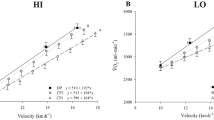Abstract.
In cycle exercise, it has been suggested that critical power, maximal lactate steady state, and lactate turnpoint all demarcate the transition between the heavy exercise domain (in which blood lactate is elevated above resting values but remains stable over time) and the very heavy exercise domain (in which blood lactate increases continuously throughout constant-intensity exercise). The purpose of the present study was to assess the level of agreement between critical velocity (CV), maximal lactate steady-state velocity (MLSSV), and lactate turnpoint velocity (LTPV) during treadmill running. Eight male subjects [mean (SD) age 28 (5) years, body mass 71.2 (8.0) kg, maximum oxygen uptake 54.9 (3.2) ml·kg–1·min–1) performed an incremental treadmill test for the determination of LTPV (defined as a sudden and sustained increase in blood lactate concentration ([La]) at ≅2.0–5.0 mM). The subjects returned to the laboratory on eight or nine occasions for the determination of CV and MLSSV. The CV was determined from four treadmill runs at velocities that were chosen to result in exhaustion within 2–12 min. The MLSSV was determined from four or five treadmill runs of up to 30 min duration and defined as the highest velocity at which blood [La] increased by no more than 1.0 mM after between 10 and 30 min of exercise. Analysis of variance revealed no significant differences between [mean (SD)] CV [14.4 (1.1) km·h–1], MLSSV [13.8 (1.1) km·h–1] and LTPV [13.7 (0.6) km·h–1]. However, the bias ±95% limits of agreement for comparisons between CV and MLSSV [0.6 (2.2) km·h–1], CV and LTPV [0.7 (2.7) km·h–1], and MLSSV and LTPV [0.1 (1.8) km·h–1] suggest that the extent of disagreement is too great to allow one variable to be estimated accurately from another in individual subjects. Direct determination of MLSSV is necessary if precision is required in experimental studies.
Similar content being viewed by others
Author information
Authors and Affiliations
Additional information
Electronic Publication
Rights and permissions
About this article
Cite this article
Smith, C.G., Jones, A.M. The relationship between critical velocity, maximal lactate steady-state velocity and lactate turnpoint velocity in runners. Eur J Appl Physiol 85, 19–26 (2001). https://doi.org/10.1007/s004210100384
Accepted:
Issue Date:
DOI: https://doi.org/10.1007/s004210100384




